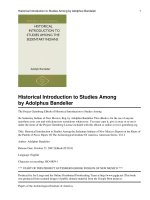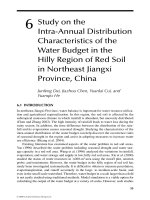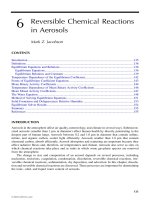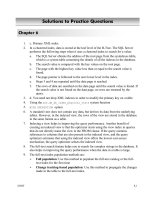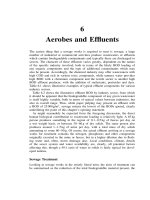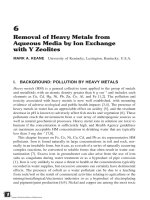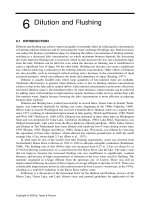Introduction to Smart Antennas - Chapter 6 docx
Bạn đang xem bản rút gọn của tài liệu. Xem và tải ngay bản đầy đủ của tài liệu tại đây (336.01 KB, 19 trang )
87
CHAPTER 6
Beamforming Fundamentals
With the direction of the incoming signals known or estimated, the next step is to use spatial
processing techniques to improve the reception performance of the receiving antenna array based
on this information. Some of these spatial processing techniques are referred to as beamforming
because they can form the array beampattern to meet the requirements dictated by the wireless
system. Given a 1D linear array of elements and an impinging wavefront from an arbitrary
point source, the directional power pattern P(θ) can be expressed as [59, 125]
P(θ) =
a(x)e
−jβd(x,θ)
dx (6.1)
where a(x) is the amplitude distribution along the array, β is the phase constant, and d(x,θ)is
the relative distance the impinging wavefront, with an angle of arrival θ, has to travel between
points uniformly spaced a distance x apart along the length of the array. The exponential term
is the one that primarily scans the beam of the array in a given angular direction. The integral
of (6.1) can be generalized for two- and three-dimensional configurations [59]. Equation (6.1)
is basically the Fourier transform of a(x) along the length of the array and is the basis for
beamforming methods [125]. The amplitude distribution a(x), necessary for a desired P(θ),
is usually difficult to implement practically [59]. Therefore, realization of (6.1)mostofthe
times is accomplished using discrete sources, represented by a summation over a finite number
of elements [59]. Thus, by controlling the relative phase between the elements, the beam can
be scanned electronically with some possible changes in the overall shape of the array pattern.
This is the basic principle of array phasing and beam shaping.
The main objective of this spatial signal pattern shaping is to simultaneously place a beam
maximum toward the signal-of-interest (SOI) and ideally nulls toward directions of interfering
signals or signals-not-of-interest (SNOIs). This process continuously changes to accommodate
the incoming SOIs and SNOIs. The signal processor of the array must automatically adjust,
from the collected information, the weight vector w =
[
w
1
,w
2
, ,w
N
]
T
which corresponds
to the complex amplitude excitation along each antenna element. It is usually convenient to
represent the signal envelopes and the applied weights in their complex envelope form [62].
88 INTRODUCTION TO SMART ANTENNAS
This relationship is represented by
r(t) = Re
x(t)e
jω
c
t
(6.2)
where ω
c
is the angular frequency of operation and x(t) is the complex envelope of the re-
ceived real signal r(t). The incoming signal is weighted by the array pattern and the output is
represented by
y(t) = Re
N
n=1
w
∗
n
(t)x
n
(t)e
jω
c
t
= Re
w
H
(t)x(t)e
jω
c
t
(6.3)
where n indicates each of the array elements and w
H
(t)x(t) is the complex envelope repre-
sentation of y(t). Since for any modern electronic system, signal processing is performed in
discrete-time, the weight vector w combines linearly the collected discrete samples to form a
single signal output expressed as
y(k) =
N
n=1
w
∗
n
x
n
(k) = w
H
x(k) (6.4)
where k denotes discrete time index ofthe received signal sample being considered. The concept
of beamforming isapplicableinbothcontinuous-time and discrete-time signals. Therefore, each
element of the receiving antenna array possesses the necessary electronics to downconvert the
received signal to baseband and for analog-to-digital (AD) conversion for digital beamforming.
To simplify the analysis of this chapter, only baseband equivalent complex signal envelopes
along with discrete-time processing will be considered herein.
Various adaptive algorithms have already been developed to calculate the optimal weight
coefficients that satisfy several criteria or constraints. Once the beamforming weight vector w
is calculated, the response of this spatial filter is represented by the antenna radiation pattern
(beampattern) for all directions, which is expressed as
P(θ) =
w
H
(θ)a(θ)
2
. (6.5)
In (6.5), P(θ) represents the average power of the spatial filter output when a single, unity-
power signal arrives from angle θ [134]. With proper control of the magnitude and phase in
w, the pattern will exhibit a main beam in the direction of the desired signal and, ideally, nulls
toward the direction of the interfering signals.
6.1 THE CLASSICAL BEAMFORMER
In classical beamforming, the beamforming weight is set tobe equal to the array response vector of
the desired signal. For any particular direction θ
0
, the antenna pattern formed using the weight
BEAMFORMING FUNDAMENTALS 89
vector w
b
= a(θ
0
) has the maximum gain in this direction compared to any other possible
weight vector of the same magnitude. This is accomplished because w
b
adjusts the phases of
the incoming signals arriving at each antenna element from a given direction θ
0
so that they
add in-phase (or constructively). Because all the elements of the beamforming weight vector are
basically phase shifts with unity magnitude, the system is commonly referred to as phased array.
Mathematically, the desired response of the method can be justified by the Cauchy–Schwartz
inequality
w
H
(θ)a(θ
0
)
2
≤w
2
a(θ
0
)
2
(6.6)
for all vectors w, with equality holding if and only if w is proportional to a(θ
0
)[134]. In the
absence of array ambiguity, theeffective pattern in (6.5) possesses a global maximum at θ
0
. Even
though the classical beamformer is the ideal choice to direct the maximum of the beampattern
toward the direction of a SOI, since the complex weight vector w can be easily derived in closed
form, it lacks the additional ability to place nulls toward any present SNOIs, often required
in pragmatic scenarios [59]. This is obvious when observing the expression in (6.5) where,
besides the look direction θ
0
, control of the beampattern cannot be achieved in the rest of the
angular region of interest. Thus, to accommodate all the requirements, a more advanced spatial
processing technique is necessary to be applied.
To demonstrate this principle, we consider a six-element uniform linear array of omni-
directional elements with half-wavelength spacing between adjacent elements. We assume that
three equal-power uncorrelated sources are transmitting signals toward the array. Furthermore,
the SOI is in the θ = 30
◦
direction, toward which it is desired for the beampattern to possess
its maximum and ideally also two nulls (for the two SNOIs) toward θ =−45
◦
and θ = 0
◦
.
Fig. 6.1 shows the two beamformed patterns: one using the classical beamformer [59]andthe
other based on a specific adaptive beamforming algorithm. As expected, the classical beam-
former directs its maximum toward the direction of the SOI but fails to form nulls toward the
directions of the SNOIs, since it does not have control of the beampattern beyond θ
0
, whereas
the adaptive beamforming algorithms achieve simultaneously to form a maximum toward the
direction of the SOI and place nulls in the directions of the SNOIs.
6.2 STATISTICALLY OPTIMUM BEAMFORMING WEIGHT
VECTORS
Depending on how the beamforming weights are chosen, beamformers can be classified as data
independent or statistically optimum. The weights in a data independent beamformer do not
depend on the received array data and are chosen to present a specified response for all signal
and interference scenarios [22]. In practice, propagating waves are perturbedby the propagating
medium or the receive mechanism. In this case, the plane wave assumption may no longer hold
90 INTRODUCTION TO SMART ANTENNAS
-90 -75 -60 -45 -30 -15 0 15 30 45 60 75 90
(degrees)
-60
-50
-40
-30
-20
-10
0
10
20
30
Beampattern (dB)
Adaptive beamforming
Classical beamforming
SOISNOI SNOI
FIGURE 6.1: Classical and adaptive beamforming.
and weight vectors based on plane-wave delays between adjacent elements will not combine
coherently the waves of the desired signal [22].
Matching of a randomly perturbed signalwith arbitrary characteristics canbe realized only
in astatistical sense by using a matrix weighting of input data which adapts to the received signal
characteristics [62]. This is referred to as statistically optimum beamforming. In this case, the
weight vectors are chosen based on the statistics of the received data. The weights are selected
to optimize the beamformer response so that the array output contains minimal contributions
due to noise and signals arriving from directions other than that of the desired signal [144].
Any possible performance degradation may result due to a deviation of the actual oper-
ating conditions from the assumed ideal and can be minimized by the use of complementary
methods that introduce constraints [22]. Due to the interest in applying array signal processing
techniques in cellular communications, where mobile units can be located anywhere in the
cell, statistically optimum beamformers provide the ability to adapt to the statistics of different
subscribers. There exist different criteria for determining statistically-optimum beamformer
weights, several of which are reviewed in this chapter.
6.2.1 The Maximum SNR Beamformer
The maximum SNR beamformer is essentially an extension of the classical beamformer. In the
presence of noise, the weight vector w that maximizes the Signal to Noise Ratio (SNR) is given
by [19]
w
maxSNR
= R
−1
nn
a(θ
0
) (6.7)
BEAMFORMING FUNDAMENTALS 91
where R
nn
is the noise covariance matrix. This beamforming weight vector gives an output
with the maximum SNR when the noise covariance matrix is known. When the noise is
spatially white, i.e., the noise covariance is a multiple of the identity matrix I, the maximum
SNR beamformer is equivalent to the classical beamformer [19]. Since only the desired signal
direction is taken into account when calculating the beamformer weight vector, as in the case of
the classical beamformer, the maximum SNR beamformer works adequately in a single-source
scenario but cannot deal satisfactorily with interfering sources [19].
6.2.2 The Multiple Sidelobe Canceller and the Maximum SINR Beamformer
In the case of more than one user in the communication system, it is often desired to suppress
the interfering signals, in addition to noise, using appropriate signal processing techniques.
There are some intuitive methods to accomplish this, for example, the multiple sidelobe canceller
(MSC) [144]. The basic idea of the MSC is that the conventional beamforming weight vectors
for each of the signal sources are first calculated and the final beamforming vector is a linear
combination of them in a way that the desired signal is preserved whereas all the interference
components are eliminated [19]. The method for a particular geometry (ULA) has been already
analyzed in a previous chapter to demonstrate the functional principle of smart antennas. MSC
has some limitations, however. For instance, for a large number of interfering signals it cannot
cancel all of them adequately and can result in significant gain for the noise component [144].
The solution to these limitations is the maximum SINR beamformer that maximizes the output
signal to interference and noise power ratio.
Recall that the output of the beamformer is given by [19]
y = w
H
x = w
H
(
s +i + n
)
= y
s
+ y
IN
(6.8)
where all the components collected by the array at a single observation instant are N ×1
complex vectors and are classified as: s is the desired signal component arriving from DOA
θ
0
, i =
I
i=1
s
i
is the interference component (assuming I such sources to be present), and n
is the noise component. In (6.8), we also separate the desired signal array response weighted
output, y
s
= w
H
s, and the interference-plus-noise total array response, y
IN
= w
H
(
i + n
)
.
Consequently, the weighted array signal output power is [22]
E
|
y
s
|
2
= w
H
E
ss
H
w = w
H
R
ss
w (6.9)
where R
ss
is the autocovariance matrix of the signal vectors s and the weighted interference-
plus-noise output power is [22]
E
|
y
IN
|
2
= w
H
E
|
i + n
|
2
w = w
H
R
IN
w (6.10)
92 INTRODUCTION TO SMART ANTENNAS
where R
IN
is the autocovariance matrix of the vectors n + i. Therefore, the weighted output
SINR can be expressed as [22]
SINR=
E
|
y
s
|
2
E
|
y
IN
|
2
=
w
H
R
ss
w
w
H
R
IN
w
. (6.11)
With appropriate factorization of R
IN
and manipulation of the SINR expression, the maxi-
mization problem can be recognized as an eigen-decomposition problem. The expression for
w that maximizes the SINR is found to be [22]
w
maxSINR
= R
−1
IN
a(θ
0
). (6.12)
This is the statistical optimum solution in maximizing the output SINR in an interference plus
noise environment, but it requires a computationally intensive inversion of R
IN
, which may be
problematic when the number of elements in the antenna array is large [19].
6.2.3 Minimum Mean Square Error (MMSE)
If sufficient knowledge of the desired signal is available, a reference signal d canthenbe
generated. These reference signals are used to determine the optimal weight vector w
MSE
=
[
w
1
,w
2
, ,w
N
]
T
. This is done by minimizing the mean square error of the reference signals
and the outputs of the N-element antenna array [145]. The concept of reference signal use
in adaptive antenna system was first introduced by Widrow in [145] where he described
several pilot-signal generation techniques. One of the proposed techniques used a two-mode
adaptation process whereby the transmitter alternated between sending a known pilot signal
and actual data. The receiver had knowledge of the pilot signal and used it as the desired
response for the LMS adaptive algorithm (described later in this chapter). During actual data
transmission, adaptation would be switched off and the weights would coast until the pilot
signal was turned back on. While an adaptive antenna utilizing this technique was probably
never constructed, the concept provided the necessary impetus which eventually grew into
actual hardware implementations [146].
For beamforming considerations, the reference signal is usually obtained by a periodic
transmission of a training sequence, which is a priori known at the receiver and is referred
to as temporal reference. Note that information about the direction of the signal of interest is
usually referred to as spatial reference. The temporal reference is of vital importance in a fading
environment due to lack of angle of arrival information [70]. As described by Compton [147],
the adaptive array reference signal need not necessarily be an exact replica of the desired signal,
even though this is what occurs in most of the cases. In general, it can be unknown but needs to
be correlated with the desired signal and uncorrelated with any possible interference. Compton
goes on to describe several experimental antenna systems designed for use with spread spectrum
BEAMFORMING FUNDAMENTALS 93
Automatic
circuit for weights’
adjustment
x
1
x
2
x
N
w
∗
1
w
∗
2
w
∗
N
Σ
Σ
e
d
y
−
+
1
2
N
•••
FIGURE 6.2: Reference signal adaptive antenna [22].
signals where the spreading sequence provides the necessary discrimination between desired
signal and interference. A tutorial discussion on adaptive beamformers with self-generated
reference signals can be found in [146].
A block diagram of an adaptive system using reference signals is shown in Fig. 6.2.At
each observation instance k, the error e(k) between the reference signal d(k) and the weighted
array output y(k) is given by
e(k) = d(k) − y(k) = d(k) −w
H
x(k). (6.13)
Mathematically, the MMSE criterion can be expressed as
min
w
E
J
w,w
∗
where J
w,w
∗
=|e(k)|
2
denotes the real-valued objective function of the weight vector w to
be solved (w
∗
is the conjugate of w). The maximum rate of change of J
w,w
∗
is given by
∂ J
w,w
∗
∂w
∗
[83, 148]. In order to get a meaningful result, the objective function needs to have
explicit dependency on the conjugate of the weight vector [23]. Usually this simply translates
into changing transposition to conjugate transposition (or Hermitian). For a more detailed
discussion on the topic, see [83, 148]. Therefore, we have
∂ J
w,w
∗
∂w
∗
=
∂
d(k) −w
H
x(k)
H
d(k) −w
H
x(k)
∂w
∗
=−2e
∗
(k)x(k).
(6.14)
94 INTRODUCTION TO SMART ANTENNAS
To minimize the objective function, we set (6.14) to zero. Considering additionally the
expectation value of the minimum of J
w,w
∗
, it yields
2R
xx
w − 2r
xd
= 0 (6.15)
where R
xx
= E
xx
H
is the signal autocovariance matrix and r
xd
= E
{
xd
∗
}
is the reference
signal covariance vector. Thus, the optimal MMSE weight solution is given by
w
MSE
= R
−1
xx
r
xd
. (6.16)
and is usually referred to as the Wiener–Hopf solution. One disadvantage using this method is
the generation of an accurate reference signal based on limited knowledge at the receiver [22].
6.2.4 Direct Matrix Inversion (DMI)
If the desired and interference signals are known a priori,(6.16) provides the most direct and
fastest solution to compute the optimal weights. However, the signals are not known exactly
since the signal environment undergoes frequent changes. Thus, the signal processing unit
must continually update the weight vector to meet the new requirements imposed by the
varying conditions [98]. This need to update the weight vector, without a priori information,
leads to estimating the covariance matrix, R
xx
, and the cross-correlation vector, r
xd
,ina
finite observation interval. Note that this is a block-adaptive approach where the statistics are
estimated using temporal blocks of the array data [70]. The adaptivity is achieved via a sliding
window, say of length L symbols. The estimates
ˆ
R
xx
and
ˆ
r
xd
can be evaluated as:
ˆ
R
xx
=
1
L
N
2
i=N
1
x(i)x
H
(i) (6.17a)
ˆ
r
xd
=
1
L
N
2
i=N
1
x(i)d
∗
(i) (6.17b)
where N
1
and N
2
are, respectively, the lower and upper limits of the observation interval such
that N
2
= N
1
+ L −1. Thus, the estimate for the weight vector is given by
ˆ
w
MSE
=
ˆ
R
−1
xx
ˆ
r
xd
. (6.18)
The advantage of the method is that it converges faster than any adaptive method, and the rate
of convergencedoes not dependon the power level of the signals. However, two major problems
are associated with the matrix inversion. First, the increased computational complexity cannot
be easily overcomed through the use ofintegrated circuits,and second, the use offinite-precision
arithmetic and the necessity of inverting a large matrix may result in numerical instability.
BEAMFORMING FUNDAMENTALS 95
6.2.5 Linearly Constrained Minimum Variance (LCMV)
In the MMSE criterion, the Wiener filter minimizes the MSE with no constraints imposed
on the solution (i.e., the weights). However, it may be desirable, or even mandatory, to design
a filter that minimizes a mean square criterion subject to a specific constraint. The LCMV
constrains the response of the beamformer so that signals from the direction of interest are
passed through the array with a specific gain and phase [149]. However it requires knowledge,
or prior estimation, of the desired signal array response a
(
θ
0
)
with DOA θ
0
. Its weights are
chosen to minimize the expected value of the output power/variance subject to the response
constraints. That is [22]
min
w
w
H
R
xx
w
subject to C
H
w = g
∗
where C ∈ C
N×K
has K linearly independent constraints and g ∈ C
K×1
is the constraint
response vector.
The constraints have an effect of preserving the desired signal while minimizing contri-
butions to the array output due to interfering signals and noise arriving from directions other
than that of interest [22]. The solution to this constrained optimization problem requires the
use of the Lagrange multiplier vector b ∈
C
K
. Letting F(w) = w
H
R
xx
w be the cost function
and G(w) = C
H
w − g
∗
be the constraint function, the following expression is formed [22]:
H(w) =
1
2
F(w) +b
H
G(w)
=
1
2
w
H
R
xx
w + b
H
C
H
w − g
∗
.
(6.19)
F(w) has its minimum value at a point w subject to the constraint G(w) = C
H
w − g
∗
= 0,
i.e., when H(w) is minimum. Therefore, to find the minimum point in equation (6.19), we
differentiate with respect to w and set it equal to zero, which yields [22]:
w
opt
=−R
−1
xx
Cb. (6.20)
Substituting w
opt
back into the constraint equation yields [22]
b =−
C
H
R
−1
xx
C
−1
g
∗
(6.21)
where the existence of
C
H
R
−1
xx
C
follows from the fact that R
xx
is positive definite and C is
full-rank. Therefore, the LCMV estimate of the weight vector is [22]
w
opt
= R
−1
xx
C
H
R
−1
xx
C
−1
g
∗
. (6.22)
96 INTRODUCTION TO SMART ANTENNAS
As a special case, a requirement would be to force the beam pattern to be constant in the
boresight direction; concisely, this can be stated mathematically as [150]
min
w
w
H
R
xx
w
subject to w
H
a(θ
0
) = g
∗
where g is a complex scalar which constrains the output response to a(θ
0
). In this case, the
LCMV weight estimate is [22]
w
opt
= g
∗
R
−1
xx
a(θ
0
)
a
H
(θ
0
)R
−1
xx
a
(
θ
0
)
. (6.23)
For the special case when g = 1 (i.e., the gain constant is unity), the optimum solution of
(6.23)istermedastheminimum variance distortionless response (MVDR) beamformer, and it
is also referred to as the maximum likelihood method (MLM) because the algorithm maximizes
the likelihood function of the input signal [98].
The advantage of using LCMV criteria is its general constraint approach that permits
extensive control over the adapted responseof the beamformer [22]. It is a flexible techniquethat
does not require knowledge of the desired signal autocovariance matrix R
xx
, the interference-
plus-noise autocovariance matrix R
IN
, or any reference signal d(k)[22]. A certain level of
beamforming performance can be attained through the design of the beamformer, allowed
by the constraint matrix [22]. However, the disadvantage of using LCMV criteria is the
computation complexity of the constraint weight vector. There are several constraint designs
for the LCMV performance such as point constraints, eigenvector constraints, etc., which are
beyond the scope of the present discussion.
6.3 ADAPTIVE ALGORITHMS FOR BEAMFORMING
As previously shown, statistically optimum weight vectors for adaptive beamforming can be
calculated by the Wiener solution. However, knowledge of the asymptotic second-order statis-
tics of the signal and the interference-plus-noise was assumed. These statistics are usually not
known but with the assumption of ergodicity, where the time average equals the ensemble aver-
age, they can be estimated from the available data [22]. For time-varying signal environments,
such as wireless cellular communication systems, statistics change with time as the target mobile
and interferers move around the cell. For the time-varying signal propagation environment, a
recursive update of the weight vector is needed to track a moving mobile so that the spatial
filtering beam will adaptively steer to the target mobile’s time-varying DOA, thus resulting in
optimal transmission/reception of the desired signal [22]. To solve the problem of time-varying
statistics, weight vectors are typically determined by adaptive algorithms which adapt to the
changing environment.
BEAMFORMING FUNDAMENTALS 97
Signal processor
Antenna array
Beam pattern-forming
Array
output
Control algorithm Adaptive
processor
Available
information
x
1
(t)
x
2
(t)
x
N
(t)
w
∗
1
w
∗
2
w
∗
N
Σ
y(t)
1
2
N
•••
FIGURE 6.3: Functional diagram of an N-element adaptive array [22].
Fig. 6.3 shows a generic adaptive antenna array system consisting of an N-element
antenna array with a real time adaptive array signal processor containing an update control
algorithm. The data samples collected by the antenna array are fed into the signal processing
unit which computes the weight vector according to a specific control algorithm.
Steady-state and transient-state are the two classifications of the requirement of an
adaptive antenna array. These two classifications depend on whether the array weights have
reached their steady-state values in a stationary environment or are being adjusted in response
to alterations in the signal environment. If we consider that the reference signal for the adaptive
algorithm is obtained by temporal reference, a priori known at the receiver during the actual
data transmission, we can either continue to update the weights adaptively via a decision
directed feedback or use those obtained at the end of the training period [70]. Several adaptive
algorithms can be used such that the weight vector adapts to the time-varying environment at
each sample; some of them are now reviewed. The text and tables, appearing in the descriptions
of the adaptive algorithms 1–2 and 4–5 that follow, are in great part reproduced and adopted
from [23] (pp. 9–15)
1
.
6.3.1 The Least Mean-Square (LMS) Algorithm
The LMS algorithm [150, 151] is probably the most widely used adaptive filtering algo-
rithm, being employed in several communication systems. It has gained popularity due to
1
The material was reproduced with the courtesy and permission of the author of [23] who retains its copyright.
98 INTRODUCTION TO SMART ANTENNAS
its low computational complexity and proven robustness [23]. It incorporates new obser-
vations and iteratively minimizes linearly the mean-square error [62, 83, 145]. The LMS
algorithm changes the weight vector w along the direction of the estimated gradient based
on the negative steepest descent method [152]. By the quadratic characteristics of the
mean square-error function E
|e(k)|
2
that has only one minimum, the steepest descent is
guaranteed to converge. At adaptation index k,givenamean-square-error (MSE) function
E{|e(k)|
2
}=E{|d(k) −w
H
x(k)|
2
}, the LMS algorithm updates the weight vector according to
[22]
w(k + 1) = w(k) −
µ
2
∂ J
w,w
∗
∂w
∗
= w(k) +µe
∗
(k)x(k)
(6.24)
where the rate of change of the objective function J
w,w
∗
=|e(k)|
2
has been derived earlier in
(6.14)andµ is a scalar constant which controls the rate of convergence and stability of the
algorithm. In order to guarantee stability in the mean-squared sense, the step size µ should be
restricted in the interval [22]
0 <µ<
2
λ
max
(6.25)
where λ
max
is the maximum eigenvalue of R
xx
. Alternatively, in terms of the total power of the
vector x [22]
λ
max
≤ trace
R
xx
(6.26)
where trace
R
xx
=
N
i=1
E
x
2
i
is the total input power. Therefore, a condition for satisfactory
Wiener solution convergence of the mean of the LMS weight vector is [22]
0 <µ<
2
N
i=1
E
x
2
i
(6.27)
where N is the number of elements in the array. The pseudo-code for the LMS algorithm is
shown in Table 6.1 [23]. A normalized version of the LMS algorithm, the NLMS algorithm
[150, 153, 154], also referred to as the projection algorithm (PA) in the control literature [155],
is obtained by substituting the step size in (6.24) with the time-varying step size µ/x(k)
2
,
where 0 <µ<2[154]. A significant drawback from the use of the LMS and the NLMS
algorithms is their slow convergence for colored noise input signals [23].
The LMS algorithm is a member of a family of stochastic gradient algorithms since the
instantaneous estimate of the gradient vector is a random vector that depends on the input data
BEAMFORMING FUNDAMENTALS 99
TABLE6.1: The Least Mean-SquareAlgorithm [22]
LMS ALGORITHM
for each k
{
e(k) = d(k) −w
H
(k)x(k)
w(k + 1) = w(k) +µe
∗
(k)x(k)
}
vector x(k)[156]. It requires about 2N complex multiplications per iteration, where N is the
number of weights (elements) used in the adaptive array. The convergence characteristics of
the LMS depend directly on the eigenstructure of R
xx
[22]. Its convergence can be slow if the
eigenvalues are widely spread. When the covariance matrix eigenvalues differ substantially, the
algorithm convergence time can be exceedinglylong and highly datadependent [62]. Therefore,
depending on the eigenvalue spread, the LMS algorithm may not have sufficient iteration time
for the weight vector to converge to the statistically optimum solution and adaptation in real
time to the time-varying environment will not be able to be performed [22]. In addition,
employing the LMS algorithm, it is assumed that sufficient knowledge of the desired signal is
known so as to generate reference signal sequences. However, acquiring this knowledge could
be very expensive for wireless communication systems, especially in fast-fading scenarios [22].
In cases where the convergence speed of the LMS algorithm is not satisfied, the following
algorithms may serve as acceptable alternatives.
6.3.2 The Recursive Least-Squares (RLS) Algorithm
Unlike the LMS algorithm [150, 157] which uses the method of steepest descent to update the
weight vector, the RLS adaptive algorithm approximates the Wiener solution directly using
the method of least squares to adjust the weight vector, without imposing the additional burden
of approximating an optimization procedure [144]. In the method of least squares, the weight
vector w(k) is chosen so as to minimize a cost function that consists of the sum of error squares
over a time window, i.e., the least-square (LS) solution is minimized recursively [23]. In the
method of steepest-descent, on the other hand, the weight vector is chosen to minimize the
ensemble average of the error squares. The recursions for the most common version of the RLS
algorithm, which is presented in its standard form in Table 6.2 [23], are a result of the weighted
100 INTRODUCTION TO SMART ANTENNAS
TABLE 6.2: The Recursive Least-Squares Algorithm [23]
RLS ALGORITHM
R
−1
(0) = δ
−1
I, δ small positive constant and
I the N × N identity matrix
for each k
{
k(k) = R
−1
(k − 1)x(k)
κ(k) =
k(k)
λ+x
H
(k)k(k)
R
−1
(k) =
1
λ
R
−1
(k − 1) −
k(k)k
H
(k)
λ+x
H
(k)k(k)
e(k) = d(k) −w
H
(k)x(k)
w(k + 1) = w(k) +e
∗
(k)κ(k)
}
least-squares (WLS) objective function
J
w,w
∗
=
k
i=1
λ
k−1
|e(i)|
2
(6.28)
where the error signal e(i) has been defined earlier and 0 <λ≤ 1 is an exponential scaling
factor which determines how quickly the previous data are de-emphasized [156] and is referred
to as the forgetting factor [23]. Usually, λ is chosen close to, but less than, unity. However, in
a stationary environment λ should be equal to 1, since all data past and present should have
equal weight [156]. Differentiating the objective function J
w,w
∗
with respect to w
∗
and solving
for the minimum yields [23]
k
i=1
λ
k−1
x(i)x
H
(i)
w(k) =
k
i=1
λ
k−1
x(i)d
∗
(i). (6.29)
Furthermore, defining the quantities [23]
R(k) =
k
i=1
λ
k−1
x(i)x
H
(i) (6.30)
and
p(k) =
k
i=1
λ
k−1
x(i)d
∗
(i) (6.31)
BEAMFORMING FUNDAMENTALS 101
the solution is obtained as [23]
w(k) = R
−1
(k)p(k). (6.32)
The recursive implementations are a result of the formulations
R(k) = λR(k −1) +x(k)x
H
(k) (6.33)
and
p(k) = λp(k − 1) +x(k)d
∗
(k). (6.34)
The inverse R
−1
(k) can be obtained recursively interms of R
−1
(k − 1) using the matrixinversion
lemma
2
[151], thus avoiding direct inversion of R(k) at each time instant k.
An important feature of the RLS algorithm is that it utilizes information contained in
the input data, extending back to the time instance the algorithm was initiated. The resulting
rate of convergence is therefore typically an order of magnitude faster than the simple LMS
algorithm. This improvement in performance, however, is achieved at the expense of a large
increase in computational complexity. The RLS algorithm requires 4N
2
+4N +2 complex
multiplications per iteration, where N is the number of weights used in the adaptive array.
Other drawbacks associated with its implementation are potential divergence behavior in a
finite-precision environment and stability problems that usually result in loss of symmetry and
positive definiteness of the matrix R
−1
(k)[23].
6.3.3 The Constant-Modulus (CM) Algorithm
Many communication signals, frequency or phase modulated, such as FM, CPFSK modulation,
and square pulse-shaped complex pulse amplitude modulation (PAM) have a constant complex
envelope [159]. Thisproperty isusually referred to as the constant modulus (CM)signal property.
For these typesof communication signals, one can take advantage of the prior knowledge of this
characteristic and specify the adaptation algorithm to achieve a desired steady state response
from the array [160]. The constant-modulus algorithm is the most well-known algorithm of this
kind. It is suitable for the transmission of a modulated signal over the wireless channel, since
noise and interference corrupt the CM property of the desired signal [159]. A signal traveling
through a frequency selective channel is almost sure to also lose its constant modulus property.
2
If A, B, C,andD are matrices with dimensions n × n, n ×m, m ×m,andm ×n, respectively, then
[
A + BCD
]
−1
= A
−1
−A
−1
B
DA
−1
B + C
−1
−1
DA
−1
, provided that the inverses of the indicated square ma-
trices exist. For a proof of the lemma, the reader is referred to [152]. A special case, known as Woodbury’s
identity, results for B being an n ×1 column vector u, C a scalar of unity and D a1× n row vector u
T
. Then
A + uu
T
−1
= A
−1
−
A
−1
uu
T
A
−1
1+u
T
A
−1
u
[158].
102 INTRODUCTION TO SMART ANTENNAS
Thus, the CM provides an indirect measure of the quality of the filtered signal. It adjusts the
weight vector of the adaptive array so as to minimize the variation of the desired signal at the
array. After the algorithm converges, a beam is steered in the direction of the signal of interests,
whereas nulls are placed in the direction of interference. In general, the CM algorithm seeks a
beamformer weight vector that minimizes a cost function of the form
J
p,q
= E
|y(k)|
p
−1
q
. (6.35)
Equation (6.35) describes a family of cost functions. The convergence of the algorithm depends
on the coefficients p and q in (6.35). Aparticular choice of p and q yields a specific cost function
called the (p,q) CM cost function.The(1, 2) and (2, 2) CM cost functions are the most popular.
The objective of CM beamforming is to restore the array output y(k) to a constant envelope
signal. Using the method of steepest descent, the weight vector is updated using the following
recursive equation,
w(k + 1) = w(k) −µ∇
w,w
∗
J
p,q
(6.36)
where the step-size parameter has been denoted by µ. When the (1,2) CM function is used,
the gradient vector is given by [156]
∇
w,w
∗
(
J
1,2
)
=
∂ J
1,2
∂w
∗
= E
x(k)
y(k) −
y(k)
|y(k)|
∗
. (6.37)
Ignoring the expectation operation in (6.37), the instantaneous estimate of the gradient vector
can be written as
∇
w,w
∗
ˆ
J
1,2
(k)
= x(k)
y(k) −
y(k)
|y(k)|
∗
(6.38)
and therefore, using (6.38), the resulting weight vector is given by
w(k + 1) = w(k) −µ
y(k) −
y(k)
|y(k)|
∗
x(k) =
= w(k) +µe
∗
(k)x(k)
(6.39)
where e(k) = y(k)/|y(k)|−y(k). Comparing the CM and the LMS algorithms, we notice that
they are very similar to each other. The term
y(k)
|y(k)|
in CM plays the same role as the desired
signal d(k) in the LMS. However, the reference signal d(k) must be sent from the transmitter
to the receiver and must be known for both the transmitter and receiver if the LMS algorithm
is used. The CM algorithm does not require a reference signal to generate the error signal at
the receiver [156]. Several other properties of the constant modulus algorithm are discussed in
[161]. The pseudo-code for the CM (1,2) algorithm is shown in Table 6.3.
BEAMFORMING FUNDAMENTALS 103
TABLE6.3: The Constant-Modulus Algorithm [23]
(1,2) CM ALGORITHM
for each k
{
y(k) = w
H
(k)x(k)
e(k) =
y(k)
|y(k)|
− y(k)
w(k + 1) = w(k) +µe
∗
(k)x(k)
}
6.3.4 The Affine-Projection (AP) Algorithm
It is well known that the normalized LMS algorithm often converges faster than the basic
LMS algorithm and in many times can effectively replace the RLS algorithm [23]. Examples
of such low-complexity algorithms are the binormalized data-reusing least mean-square (BN-
DRLMS) [162], the normalized new data-reusing (NNDR) [163], and the affine-projection
(AP) [164–166] algorithms. Studies have shown that the idea of reutilizing past and present
information in the coefficient update, referred to as data-reusing, to be a promising approach in
achieving balance between convergence speed and computational complexity of the algorithm
[23]. The BNDRLMS algorithm utilizes current and past data-pairs in its update. The rela-
tionships between a number of reusing algorithms are addressed in [167]. The AP projection
algorithm can be seen as a general normalized data-reusing algorithm that reuses an arbitrary
number of data-pairs. It updates its coefficient vector such that the new solution belongs to
the intersection of P hyperplanes defined by the present and the P − 1 previous data pairs
x(i), d(i)
k
i=k−P+1
. The optimization criterion used for the derivation of the AP algorithm is
given by
w(k + 1) = arg min
w
w − w(k)
2
subject to d(k) = X
T
(k)w
∗
where
d(k) =
[
d(k), d(k −1), ,d(k − P +1)
]
H
and (6.40a)
X(k) =
[
x(k), x(k −1), ,x(k − P +1)
]
. (6.40b)
The updating equations for the AP algorithm obtained as the minimization problem in (6.3.4)
are presented in Table 6.4 [23]. To control stability, convergence, and final error, a step size µ
is introduced where 0 <µ<2[165]. To improve robustness, a diagonal matrix δI is used to
104 INTRODUCTION TO SMART ANTENNAS
TABLE 6.4: The Affine-Projection Algorithm [23]
AP ALGORITHM
for each k
{
e(k) = d(k) −X
T
(k)w
∗
(k)
t(k) =
X
H
(k)X(k) + δI
−1
e
∗
(k)
w(k + 1) = w(k) +µX(k)t(k)
}
regularize the inverse matrix in the AP algorithm, where δ is a small positive constant and I is
an N × N identity matrix [23].
6.3.5 The Quasi-Newton (QN) Algorithm
The fast convergence of the RLS algorithm relies on the estimation of the inverse of the
correlation matrix R
−1
(k) which is required to remain symmetric and positive definite for the
algorithm’s stability [23]. However, implementation in finite precision may cause R
−1
(k)to
become indefinite [168]. One algorithm that provides convergence speed comparable to that
of the RLS algorithm, but is guaranteed to be stable even under high input-signal correlation
and fixed-point short-wordlength arithmetic, is the quasi-Newton (QN) algorithm [168, 169].
In the QN algorithm, the weight vector is updated as
w(k + 1) = w(k) +µ(k)h(k) (6.41)
where µ(k) is a step size obtained through an exact line search, and h(k) is the direction of the
update given by
h(k) =−R
−1
(k − 1)
∂ J
w,w
∗
∂w
∗
(6.42)
where the cost function is once more J
w,w
∗
=|e(k)|
2
. Performing an exact line search results in
a step size [168]
µ(k) =
1
2x
H
(k)R
−1
(k − 1)x(k)
. (6.43)
The update of R
−1
(k − 1) is crucial for the numerical behavior of the QN algorithm, and differ-
ent approximations lead to different QN algorithms [23]. For an approximation of R
−1
(k − 1),
BEAMFORMING FUNDAMENTALS 105
TABLE 6.5: The Quasi-Newton Algorithm [23]
QN ALGORITHM
for each k
{
e(k) = d(k) −w
H
(k)x(k)
t(k) = R
−1
(k − 1)x(k)
τ (k) = x
H
(k)t(k)
µ(k) =
1
2τ (k)
R
−1
(k) = R
−1
(k − 1) +
[
µ(k)−1
]
τ (k)
t(k)t
H
(k)
w(k + 1) = w(k) +α
e
∗
(k)
τ (k)
t(k)
}
which is robust and remains positive definite even for highly correlated input signals and
short wordlength arithmetic, as given in [168], the QN algorithm can be implemented as
shown in Table 6.5 [23]. In Table 6.5 a positive constant α is used to control the speed of
convergence and the misadjustment. Convergence in the mean and the mean-squared sense
of the weight vector is guaranteed for 0 <α<2 provided that R
−1
(k − 1) is positive definite
[168–170].
